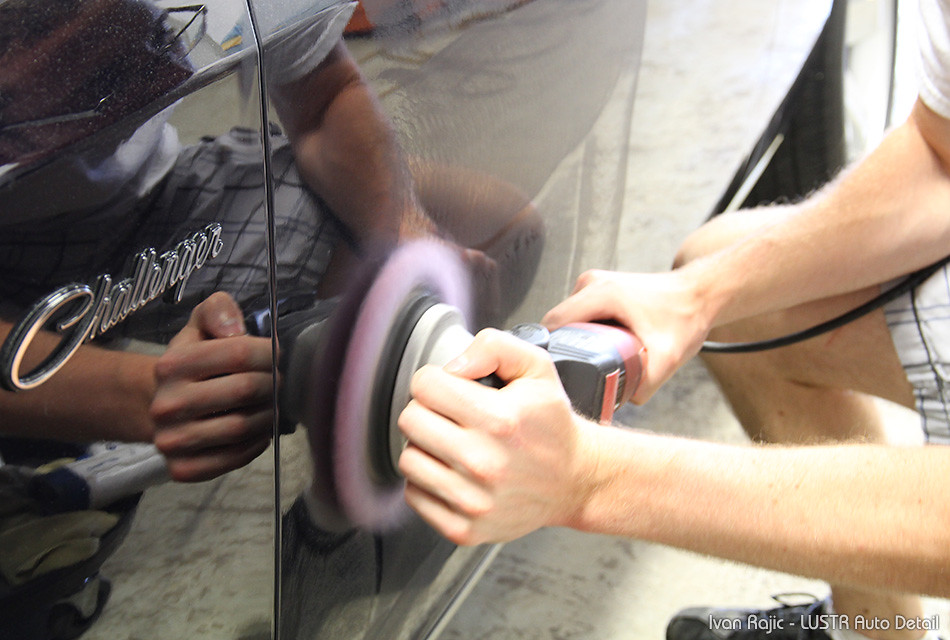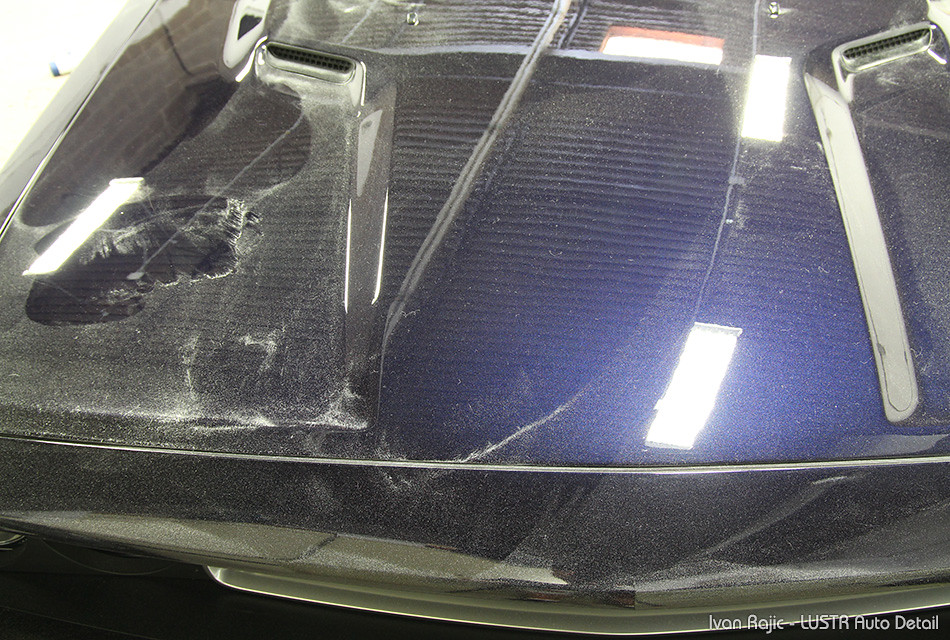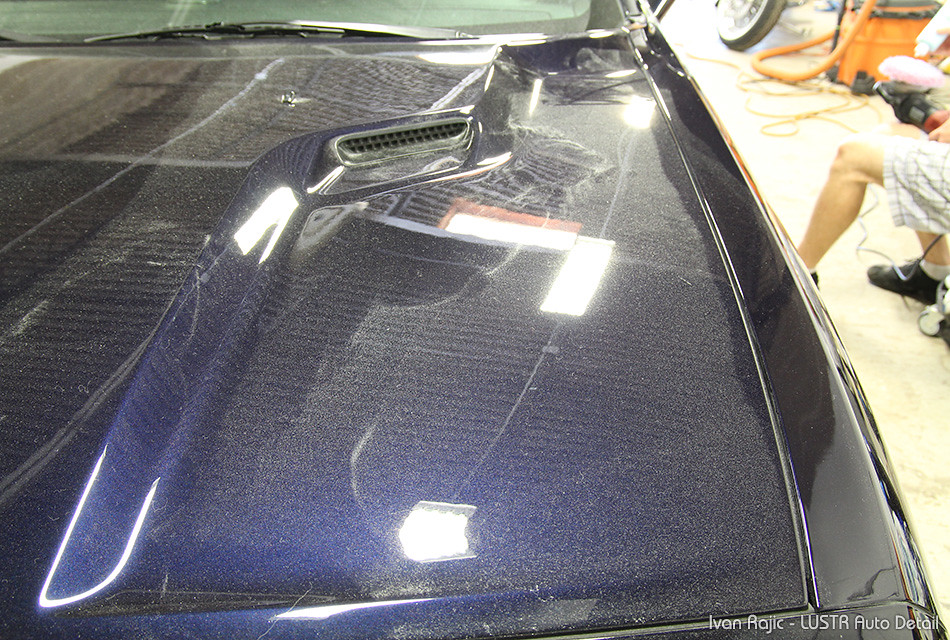Dust When Polishing & How To Reduce It
by Ivan RajicWe’ve all seen it, especially when working with some aggressive compounds and polishes, such as Meguiar’s 105, Menzerna Power Gloss and Poorboy’s SSR3. All three of these are polishes meant for some fairly serious swirl mark removal, so they tend to be abrasive and leave quite a bit of dust behind. We tend to use a lot of Meguiar’s 105 paired with a Lake Country Purple Foamed Wool Pad with the Flex 3401 polisher.

After only a couple sections of polishing, this is what the car starts to look like…


Unfortunately, most of the time, it’s just the nature of the beast. The dust comes from the actual polish, the paint being removed and also some of it is simply the fibers of the wool pad coming off. The photos above show dust that’s typically found after using a wool pad. Foam pads don’t normally leave this much dust. Reason being, foam pads are enclosed in a way and contain the dusting both by keeping the polish and paint residue on the surface of the pad, but also by absorbing some of the polish both initially and also once it starts dusting. Wool pads on the other hand are more “open” and the fibers go in all directions without much containment, so the dust coming from under it is more likely to escape.
There aren’t many ways to avoid dust because it simply has to go somewhere. It comes from the polish breaking down (polish basically turns from liquid to dust or abrasive particles as the lubricating oils dry up during the polishing cycle) and also from the paint being removed. The dust coming from the paint is something that surely can’t be avoided as that is the purpose of the whole process in the first place. This is most noticeable when working on paint that is a single stage, meaning no clear coat. What happens is the pads will start showing the color of the car and the dust all around the vehicle will be a certain color. I will try to get a photo soon of an upcoming red Supra we will be working on, but I believe there is an existing article on here showing exactly what I’m talking about here. First to find it gets a prize :).
In any case, the dust from polishing is what can be reduced to an extent and will surely help with the cleanup process and prep for the next polishing stages. As mentioned above, one way to reduce dust is by avoiding wool pads. However, this should be done only in the case that the results provided by a foam pad are the same or better as that of a wool pad. I would much rather have to clean up more dust after while getting great results from only one stage of polishing with a wool pad, instead of little dust cleanup after having to do two stages with a foam pad. Hope that makes sense. Another way to reduce dust would be to experiment with the polishing cycles of different products. The longer you work with a polish, the more it tends to dust, so if you are able to get the same results from 30 seconds of polishing and 45 seconds of polishing an area, go for 30 seconds as there will be less dust to clean up. Lastly, there are products such as the Chemical Guys Polishing Pad Conditioner, which help reduce the dusting a bit by making the pads more damp. I’m not the biggest fan of these as I like to just use the polish and make sure I can get the most of it without any interference, but it should help.
Hopefully some of this sheds a bit of light on the subject and I’d love to hear any tips from the other authors as well as readers!










Not sure if it’s the article you were talking about, but the below review of the Meguair’s MF system shows quite a bit of single-stage red paint off a Ferrari on the pads.
https://www.detailedimage.com/Ask-a-Pro/meguiars-da-microfiber-polishing-system/
great info as always, Ivan. Could you do a one stage with 105 and wool pad and go straight to sealant or should you always follow up 105 with 205? Also, how well would a wool pad work with 205?
You should always follow up with a polishand foam pad. Using a wool pad leaves marring and swirls. You will need to polish these out and then you will be able to use a sealant or such to seal the surface.
Tony is spot on. I never like to use wool as the last step. Even on very hard paint where it looks absolutely perfect, I will do a very quick pass with a foam pad and a medium to light finishing polish to ensure no light micromarring comes back later. Wool works great with M205 from my experience, you just have to use it in the right situation.
I’ve ran into issues with M105 drying out (or dusting) too quickly when working on a soft clear coat over carbon fiber. I misted a little quick detailer over the area prior to starting and it seemed okay. I got 3-5 passes this way rather than 1-2. M105 seemed okay with it, removal wise, but M205 did not do well (nor did it need it, just experimenting). Should I have tried using more M105 rather than QD? It was also very dry outside when I did this.
Hi Kevin,
What you described can be attributed both to product amount (too much, too little) but also some paint can be very finicky (for us it has been mainly Subarus) and it’s nearly impossible to perform a simple single stage polishing step. All polishes should be able to have a good work time with the right technique and the right amount of product, but sometimes it will be hard to figure out this “right” amount and will take a while. I’ve many times polished a couple panels before finally saying “Oh, so that’s the amount/speed/pressure/etc needed for this paint”.
If it is in fact the paint you’re working with, then some aids like the quick detailer, pad misters, etc. can be great help in reducing both the experimenting time and stress associated with dealing with this issue. In short, if you found quick detailer to be of help to you, great. You can experiment a bit more in terms of amount of polish and pressure on that certain paint, but at the end of the day if you get the results you expect or better, that’s all that matters.
I do allot of detail work on subarus. I own an 06 STi and allot of my clientele co.es from my Subaru club. Very soft touchy clear coat. I’ve found you almost CANT use the M105 with subarus. I mean you can, but they are very picky about it. But if I do a Ford, or Hyundai. I’ve noticed I can even finish with the 105. Pretty strange how big of a difference different paints make. Great write up!!
Why not use a duster? You know the ones that car places sell to dust off your car on a daily basis. It would remove a lot of that dust quickly and easily – that is its job.
Yes, you have to be smarter than the brush, meaning that you have to use the correct amount of pressure to do the job – but again you are not trying to get down to a perfect surface either. You are dusting to remove most of the dust accumulation, especially in the work area.
Using compressed air, you can remove most of the picked up matter from the duster and keep using it. You could just blow it off the vehicle – but the dust has to go somewhere!
you should never finish with 105. The finish will always be left in a hazy state. Follow it up with something like sonax perfect finish, carpro reflect, or 205 at the minimum. your paint will thank you!
Removing all that dust will go quick if you have access to an air compressor. blast it all off and continue onto the next stage in polishing.
I agree, there are times when wool and 105 work wonders, but the insane amount of dust is a little disturbing…especially on black lambos!